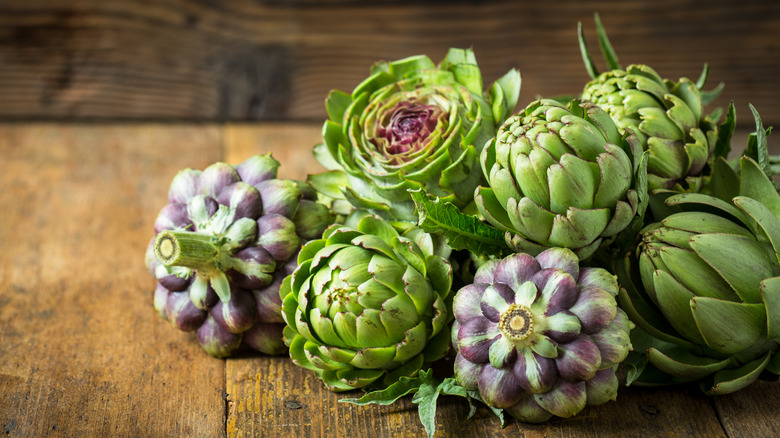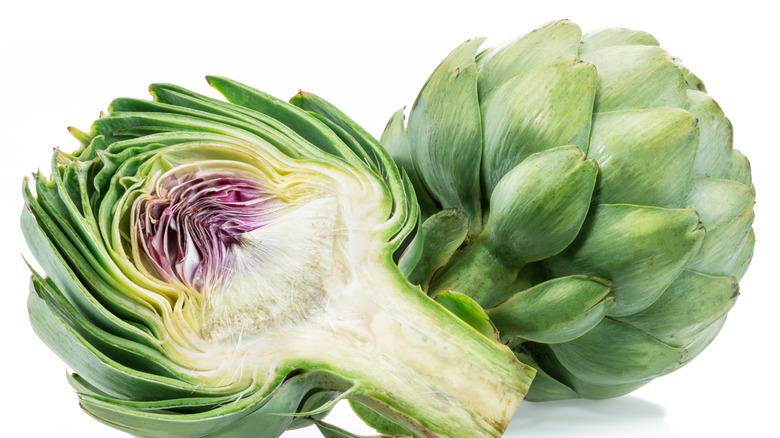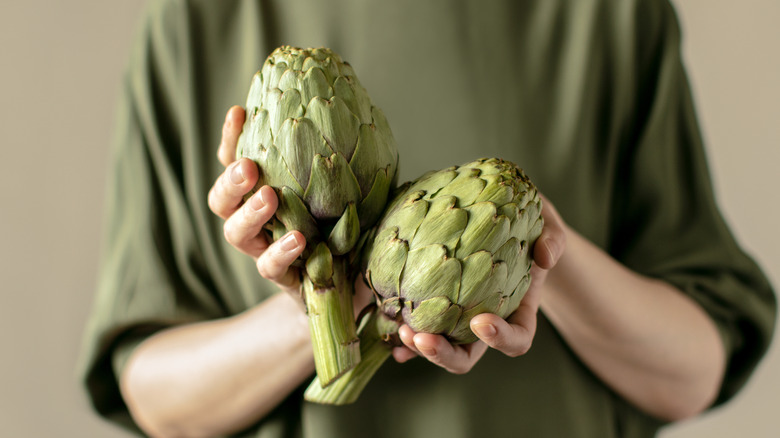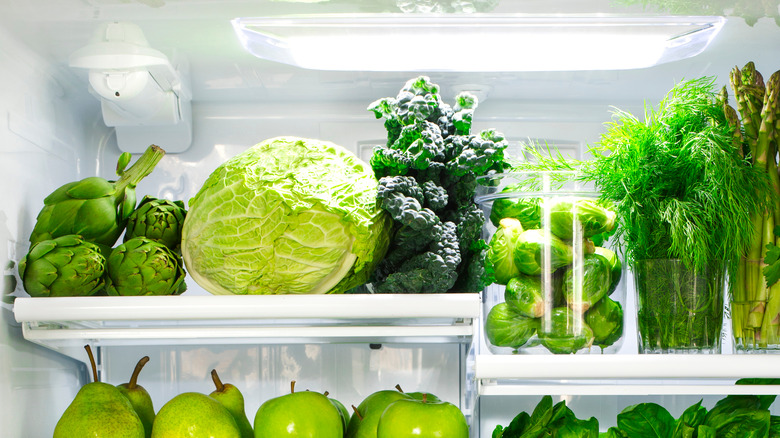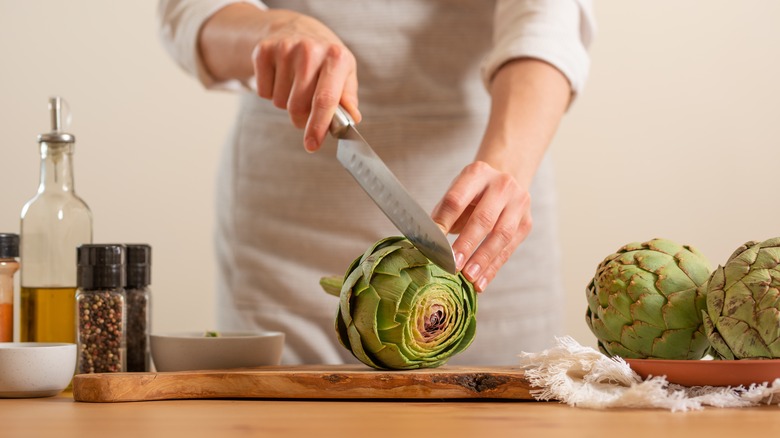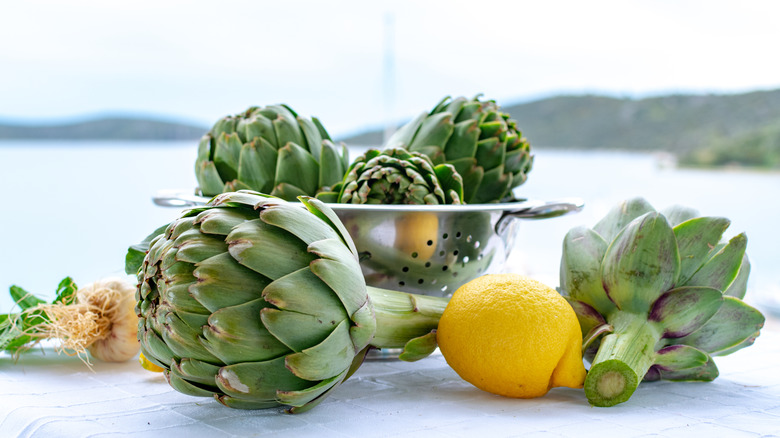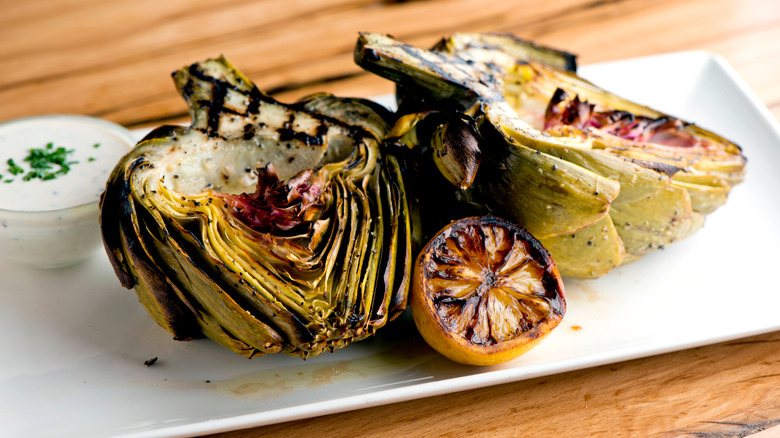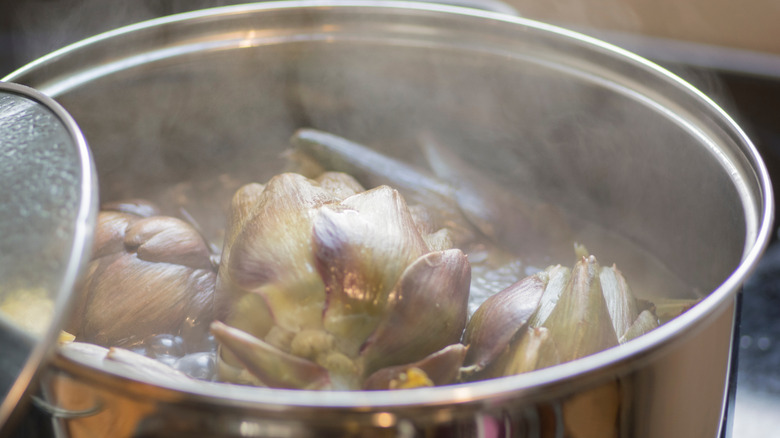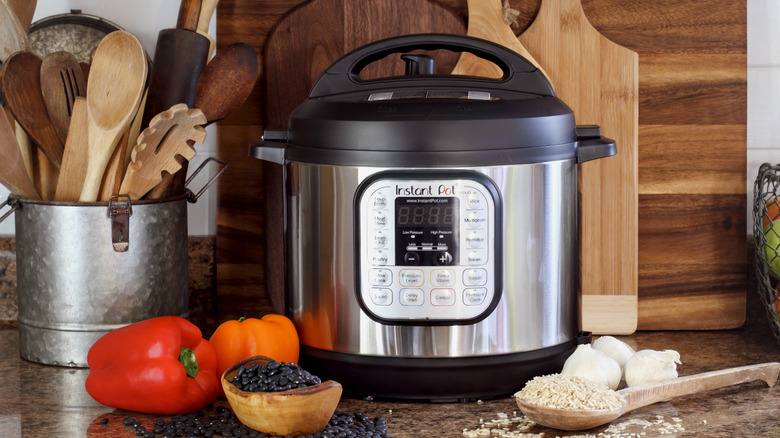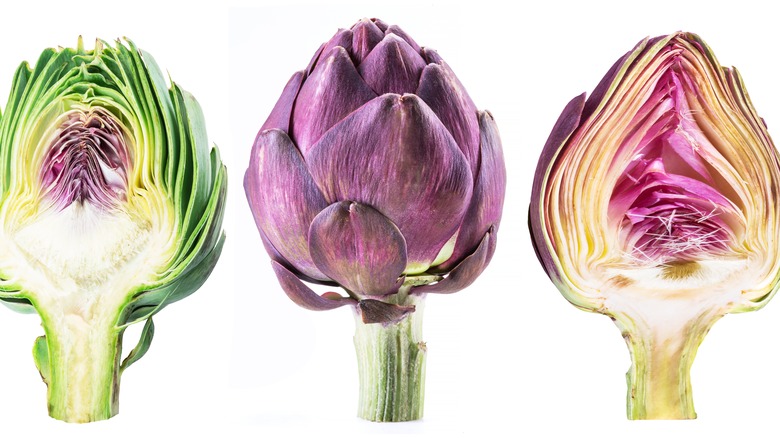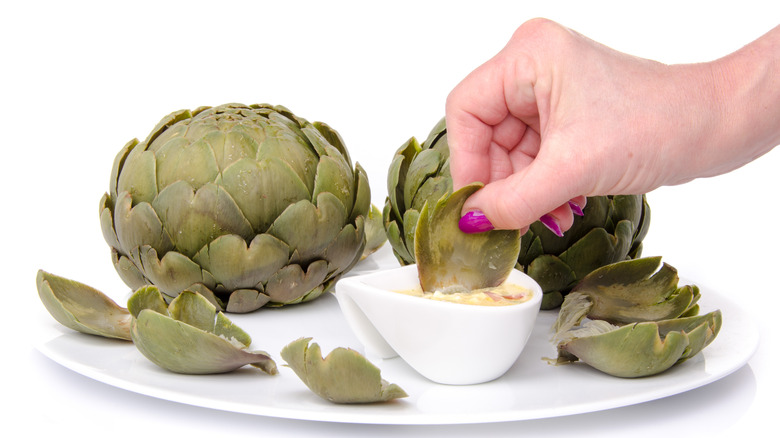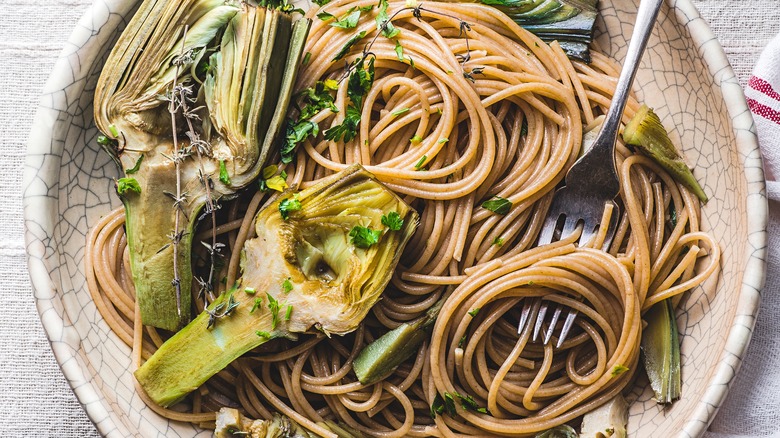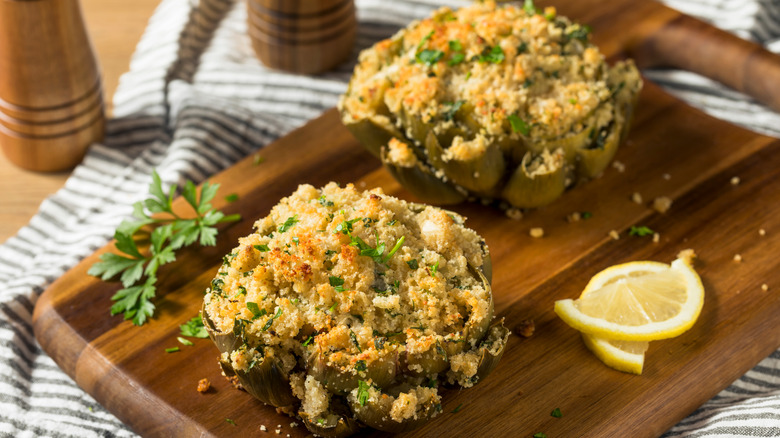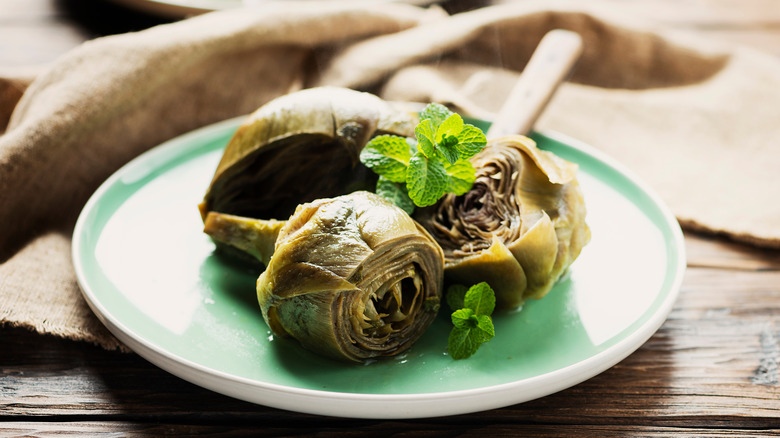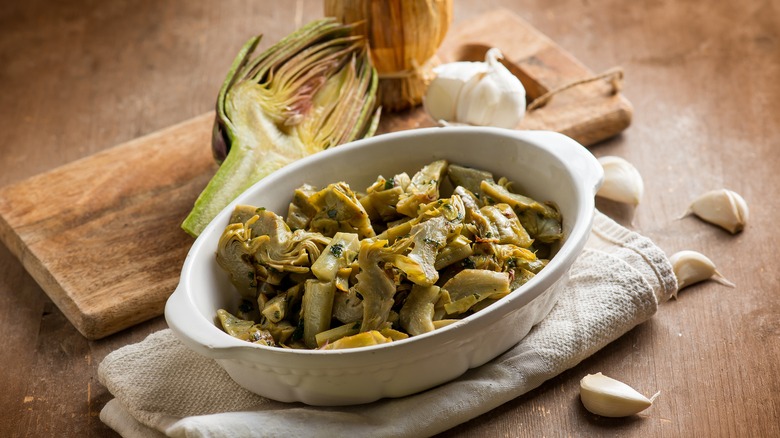The 14 Biggest Mistakes Everyone Makes With Artichokes
Whether you grew up eating artichokes or only recently discovered what these vegetables are even called, you may be searching for the right way to cook them. Artichokes can be intimidating. They don't look like other vegetables that we're more accustomed to making, such as carrots, mushrooms, zucchini, or broccoli. With their prickly leaves, many people are also unsure how to handle them, let alone prepare, cook, or serve them.
Fortunately, artichokes are easier to cook than many people realize. While they aren't that difficult to prepare, there are still several common mistakes that people make with them. Whether you've been wanting to try making artichokes for the first time, or you have already cooked them many times at home, learning about these blunders will help you understand what to avoid. You won't be sorry when you bite into that tender and delicious artichoke heart. Here are the 14 biggest mistakes everyone makes with artichokes.
1. Being scared to cook them
If you've never attempted to cook an artichoke because you're afraid of them, then that's the first mistake you've been making. If you never try, you'll never know how amazing your artichokes could taste.
We understand. Artichokes are a bit scary. They have prickly leaves and a long stem. If you've eaten artichokes in a restaurant, you know that there is a tasty heart hidden somewhere inside all of those leaves, but may not understand how you're supposed to get at it. Are you supposed to take off all of those leaves before or after cooking? Can you even eat the leaves themselves? If so, which parts of them are edible?
These are all valid questions, but not ones that should stand in your way of trying to cook artichokes. Fortunately, we'll be addressing all of these questions in the upcoming sections, so you can find all the answers you've been looking for and finally attempt to cook artichokes yourself.
2. Not choosing fresh, in-season artichokes
One key to getting your artichokes to taste good is starting with the right artichoke. You need to be selective when choosing an artichoke from the produce section at the grocery store — and sadly, the available options may not always be worth buying. You'll have the best luck finding good artichokes during their peak seasons. There are two peak seasons for artichokes. The first runs from March to June, and the second runs from September to October.
Even if you're shopping during one of the peak seasons, you'll also want to closely inspect the artichoke to make sure it looks fresh. The leaves should be tightly packed around the center; there should not be a lot of space between them. If you give a fresh artichoke a light squeeze, you should hear a quiet squeak from the leaves. Fresh artichokes should also feel relatively heavy for their size. This means that they are still retaining plenty of moisture, which will result in a better taste when cooked. The leaves of a fresh artichoke may have some natural discoloration. However, if the leaves are looking shriveled or have splits in them, the artichoke is not at peak freshness. Similarly, if the artichoke feels too dry when you squeeze it, you should pass it up and look for another one.
3. Storing them improperly
Once you pick out your fresh artichokes and bring them home, you need to make sure you store them properly if you won't be cooking them right away. If stored right, fresh artichokes can last for about one week. However, if they are not stored correctly, they're likely to dry out and may only last a few days before their flavor diminishes.
To keep your artichokes as fresh as possible before you're ready to cook them, individually wrap each in a paper towel. The paper towel will absorb moisture, which could otherwise cause the artichokes to go bad more quickly. While you can keep your artichokes in the fridge for a few days, the best option is still to purchase them as close to when you are planning to cook them as possible. This will help ensure that they are at peak freshness, meaning you don't have to wait long to eat your artichokes.
4. Preparing the artichokes wrong
One of the biggest mistakes people make when cooking artichokes is not preparing them properly. As we shared earlier, with their prickly leaves and odd shapes, artichokes look very different from most other vegetables. This can leave lots of questions about what you're supposed to do to get them ready to cook. But we've got you covered.
The first thing you'll need to do is peel off any of the very small leaves attached to the stem. These aren't going to be edible and will interfere with the final presentation of the cooked artichoke. You will also want to trim the stem — but just enough of the tip to clean it up and remove the browned part. The stem is edible, and cutting too much of it off can make it more difficult to eat the heart once the artichoke is cooked. Take care not to remove too much of it. Finish off the preparation of the stem by scoring the end with your knife. This isn't necessary, but it will help the artichoke cook a little faster.
You can also cut off the top of the artichoke leaves. Again, this step is not required. However, the tops of the leaves are prickly. Plus, leaving the leaves on the artichokes will make them take up more space in your pot or pan when cooking.
5. Forgetting to prevent them from browning
After you trim the leaves and the stems of the artichoke, there is one more step you will want to take to make sure that the artichoke doesn't turn brown when cooking it. The freshly trimmed sections of the stem and the top of the leaves are likely to brown, due to oxidation, as they are exposed to the air. Brushing these cut areas with a sliced lemon will help prevent this process from occurring, allowing the artichoke to remain green.
If the artichoke does turn brown, it will not affect its taste or quality. However, if you are serving artichokes with your meal, you want them to not only taste good but also look appetizing. Make sure that you have a lemon or some lemon juice on hand before you start trimming the artichokes. If you don't have any lemons, you can also use a lime.
6. Choosing incorrect cooking methods
Put some thought into how you want to cook your artichokes. There are actually several different options when it comes to cooking artichokes. Each will offer a slightly different taste and texture, which could better match your preferences or the other components of your meal.
One popular cooking method is steaming. Steaming artichokes is also very easy. You'll just need a steamer basket and a large pot. Add the artichokes to the steamer basket, pour about 1 inch of water and some lemon juice into the pot, and steam the artichokes for about 40 to 45 minutes. To do so, bring the water to a boil, then turn down the heat to let it simmer. You'll know that the artichoke is ready to eat when the outer leaves are easy to remove.
You can also grill artichokes for a delicious treat. To do this, slice the full artichoke in half, lengthwise, and boil each half on the stovetop for about 15 minutes to make sure they are tender enough. Prepare them for the grill by draining all the water away and brushing them with some oil and the seasoning of your choice. Other cooking options for artichokes include roasting, frying, and braising.
7. Cooking artichokes for the wrong amount of time
An artichoke's taste and texture will be off if it is undercooked or overcooked. When undercooked, the leaves will not peel off easily, and the flesh at the end of them will be too tough to enjoy. Similarly, an undercooked artichoke heart is not very enjoyable. It tastes hard and chewy, a stark contrast to the tender and scrumptious heart that you're expecting. While you don't want to undercook your artichokes, you also don't want to overcook them. If you steam or boil an artichoke for too long, the heart and leaves could turn way too soft. The artichoke could even fall apart when you pick it up.
While the length of time will vary based on the size of the artichoke you're preparing. However, there are some general guidelines to follow for different cooking methods. For example, expect it to take between 35 and 60 minutes to steam an artichoke, about 25 to 35 minutes to roast cut artichoke pieces, around 15 minutes to cook an artichoke in a pressure cooker, and about 5 to 10 minutes (plus about 15 minutes of boiling time) to grill an artichoke.
8. Not using an Instant Pot
Have you tried cooking artichokes in your Instant Pot? If not, you're missing out. Not only can using an Instant Pot simplify the task of cooking an artichoke, but it can also help you achieve a beautifully-cooked and tasty finished product.
To cook an artichoke in the Instant Pot, prepare it using the same methods as you would for boiling or steaming. Add 1.5 cups of water to the bottom of the device, then place the artichokes on the trivet, cut side down. Close the Instant Pot and set a cooking time of 15 minutes at high pressure. Let the pressure release naturally, remove the artichokes, serve, and enjoy. If you're cooking more than one artichoke at the same time in your Instant Pot, choose ones of a similar size. This will help them to cook more evenly. You should also add about 5 minutes to the cooking time if needed.
9. Misunderstanding which parts are edible
If you have never eaten an artichoke before, it's understandable that you might not even know where to start when it comes to eating one. These vegetables include several different components — and only some of them are edible. Let's start on the outside and work our way in to describe the different parts of an artichoke, to help you understand what you can and cannot eat.
The outer layers of an artichoke are composed of leaves, which come in many layers. While you cannot eat the upper prickly part of the leaves, you can eat the more tender flesh on their base. This flesh will be the most tender on the inner leaves closer to the heart.
Once you get through the leaves, there is a fuzzy artichoke component called "the choke" covering the heart. This part is not edible, so you'll want to discard it. You may need a spoon or knife to separate the choke from the top of the artichoke heart. Work carefully. You don't want to accidentally cut off and waste the heart, as it's the tastiest party of the vegetable. Once you've removed the choke, you can enjoy this tender piece, along with the stem.
10. Not knowing how to eat them
Now that you know which parts of the artichoke you can actually eat, how are you supposed to eat them? We've got the answer. You'll want to start from the outside and work your way in. As shared above, the softer flesh along the bottom tip of each leaf is edible. The best way to eat this is to put the tip of the leaf in your mouth and use your teeth to scrape the flesh off. You don't want to actually bite the leaves, as the outer surface of it will be too chewy. As you work your way toward the center, the flesh softens, making it easier to scrape each leaf.
Once you've removed most of the leaves individually, the last batch of them can typically be pulled off as a group. Before eating the tips of these leaves, use your fingers to reach into the cavity to pull out the inner prickly section — if you haven't removed the choke already. Removing the last batch of leaves will expose the fuzzy choke. Carefully remove it using a spoon, then pick up the artichoke by the stem to eat the heart. You can also eat the stem, though you may only want to eat the very top of it. As you get farther down, it can get stringier.
11. Pairing them with the wrong foods
If you want your artichokes to taste best, then it's important to serve them with complementary foods. Artichokes are most commonly served as a side dish or an addition to a main meal. If you're planning to serve artichokes this way, consider pairing them with a protein, such as seafood, chicken, or pork. If you're looking for other side dishes to complement your artichoke, try rice pilaf, mashed potatoes, or roasted sweet potatoes. A nice dipping sauce, such as mayonnaise, melted butter, hollandaise sauce, or a homemade cream sauce can enhance the flavor of the artichoke.
In addition to serving artichokes as a side, you can also add them to a main dish. If you're choosing this option, you'll most likely want to serve only the artichoke heart. Consider adding hearts to a pizza or sandwich, mixing them into pasta, or using them as a salad topping.
12. Not making stuffed artichokes
Once you've had some experience with artichokes, it is time to start branching out to new preparation methods. One of the recipes you'll want to try is stuffed artichokes. You probably already know that you can stuff tomatoes or peppers to make a delicious meal, but did you realize that you can also stuff artichokes full of various ingredients to make them more hearty and enjoyable? If not, now you do.
Stuffed artichokes aren't too difficult to make. You'll want to start by preparing them similarly to the way you would for steaming or grilling: trim the stem, cut off the top of the leaves, and remove the choke. Then, you'll need to use your fingers to spread the leaves out to make space for the stuffing. After preparing your stuffing mix — typically with breadcrumbs, cheese, and various seasonings — push one-quarter to one-third of the mixture in between the tops of the leaves, towards the center of the artichoke. Then, cover the top of the artichoke with the remainder of the mixture. You can cook your stuffed artichokes on the stove or even in the slow cooker, and then transfer them to the oven for the last few minutes to brown the breadcrumb mixture.
13. Improperly storing leftovers
Proper storage of leftover artichokes is important. This helps to ensure that your artichokes stay safe to eat. It also helps to maintain the proper taste and texture. First, it's important to avoid leaving cooked artichokes out on the counter or table for more than two hours after cooking. Doing so will increase the risk of bacteria growth, which can cause foodborne illnesses if consumed.
If you plan on eating the leftover artichokes within a few days, they can be kept in the refrigerator. Wrap them up with plastic wrap or choose a large, airtight container, then put them in the fridge Eat the artichokes within 5 days.
If you do not think you'll be able to finish off the leftover artichokes within a few days, freezing them is better. You can either put the artichokes in a freezer-safe plastic bag or a freezer-safe airtight container. For the best taste, eat frozen artichokes within a few months. Don't forget to allow the artichokes time to defrost before reheating them.
14. Not knowing how to reheat them
If you have leftover artichokes, you will also need to know how to reheat them. While artichokes taste good cold, it's best to reheat previously cooked items for food safety. There are a few different options you can choose from.
The first one is the oven. This will also be the best way to reheat stuffed artichokes or pasta dishes using artichokes. For whole artichokes, start by drizzling them with a bit of olive oil to help them stay moist. Then, wrap them in aluminum foil and place them in an oven set to 350 degrees.
The microwave can also come in handy when reheating artichokes. Place about 1 teaspoon of water in the bottom of a microwave-safe bowl. Then, put the artichokes in the bowl, cover the bowl, and heat it up. Start with about 30 seconds, then add 20 seconds at a time until the artichokes are warm.
Finally, you can also reheat your artichokes on the stovetop, through steaming. Add about 1.5 inches of water to the pot, then pour in 1.5 to 2 tablespoons of olive oil. Place the artichokes in the pan with some additional olive oil. Steam them for 20 to 30 minutes until warm.
